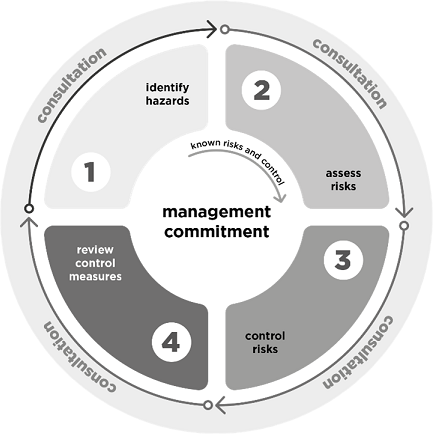Table of Contents
From low job control to role ambiguity, various factors can contribute to work-related stress, burnout, and mental health issues. It’s no surprise that managing psychosocial hazards in the workplace has become a critical priority for organisations.
Identifying and addressing these risks is not only a legal obligation under the Health and Safety at Work Act 2015 (HSWA), but also essential for fostering a thriving, productive, and engaged workforce. However, many organisations struggle with understanding their responsibilities, assessing psychosocial risk, and implementing effective control measures as far as is reasonably practicable.
In this blog post, we’ll explore the nature of psychosocial hazards, their impact, and strategies for managing them. You’ll be equipped with the knowledge and tools needed to proactively address this challenge.
What Are Psychosocial Hazards?
Psychosocial hazards refer to aspects of work design and management, and its social and organisational contexts, that have the potential to cause psychological or physical harm.
In essence, they are features of the work environment that can negatively impact worker mental health and well-being.
Some common psychosocial hazards examples include:
- High job demands
- Low job control
- Poor support from supervisors or colleagues
- Lack of role clarity
- Poorly managed organisational change
- Bullying, harassment, and violence
- Isolated or remote work
- Traumatic events
These hazards may arise from the way work is designed, organised, and managed. For example, a job with a high workload, tight deadlines, and little autonomy exposes a worker to psychosocial risks like work-related stress and burnout.
Psychosocial hazards are a serious concern because prolonged exposure can lead to both mental and physical health problems. Anxiety, depression, sleep disorders, cardiovascular disease, and musculoskeletal disorders have all been linked to work-related stressors.
Prevalence of Psychosocial Hazards in New Zealand
A 2009 study found that 17.8% of New Zealand workers reported being bullied at work in the previous 6 months.
More recently, the 2021 WorkSafe New Zealand Psychosocial Survey of 3,612 workers found that:
- 35% reported being exposed to at least one offensive behaviour in the past 12 months
- 23% reported being bullied, making it the most common hostile act
- 16% experienced cyberbullying
- 14% faced threats of violence
- 11% experienced sexual harassment
- 11% reported being subjected to physical violence
These figures suggest that a substantial portion of the New Zealand workforce is regularly exposed to psychosocial risks. Certain industries, such as healthcare, education, and hospitality, tend to have higher rates of psychosocial hazards due to the emotionally demanding nature of the work.

Impact of Psychosocial Hazards on Worker Health and Safety
Psychological Effects
Prolonged or intense exposure to psychosocial hazards can have serious consequences for workers’ mental health.
A meta-analysis found that job strain, which arises from the combination of high work demands and low job control, increases the risk of common mental disorders like depression, anxiety, and post-traumatic stress disorder by 30–80%. Other studies have linked workplace bullying to clinical levels of suicidal ideation.
Psychosocial risks can also exacerbate pre-existing mental health conditions. For example, a person with social anxiety disorder may find their symptoms are triggered or worsened by an unsupportive or critical work environment. This bi-directional relationship between work and mental health underscores the importance of providing a psychologically safe workplace.
Physical Health Consequences
Work-related stress doesn’t just affect the mind – it can also take a toll on the body. Chronic stress leads to dysregulation of the physiological stress response system, increasing inflammation and suppressing immunity.
This helps explain why workers exposed to high levels of psychosocial risk show elevated rates of:
- Coronary heart disease and stroke
- Type 2 diabetes
- Musculoskeletal pain, especially back problems
- Headaches and migraines
- Gastrointestinal disorders like irritable bowel syndrome
Exposure to bullying, violence, and other abusive behaviours at work can also directly cause physical injuries. In extreme cases, psychosocial hazards have even been implicated in cardiovascular events like heart attacks and sudden deaths.
Organisational Impacts
In addition to the human costs, uncontrolled psychosocial hazards can have major bottom-line implications for organisations.
Work-related stress and mental health issues are leading causes of sickness absence, presenteeism (working while unwell), and turnover. The resulting losses in productivity are estimated to cost the New Zealand economy over $1.5 billion per year.
Psychosocial risks can also damage an organisation’s reputation, making it harder to attract and retain talent. In a tight labour market, workers increasingly expect and seek out employers who prioritise employee well-being. Failure to provide a mentally healthy work environment is likely to put an organisation at a competitive disadvantage.
Legal Obligations for Managing Psychosocial Hazards at Work
Under the HSWA, organisations have a primary duty of care to ensure, so far as is reasonably practicable, the health and safety of workers. The definition of health includes both physical and mental health, so this duty extends to protecting workers from psychosocial hazards.
Specifically, section 36 of the HSWA requires organisations to:
- Identify hazards and assess their associated risks
- Eliminate risks so far as is reasonably practicable, and where not practicable, minimise them
- Maintain effective control measures
- Review control measures to ensure they remain effective
- Consequences of non-compliance
Failure to comply with the HSWA can result in significant penalties, including fines of up to $3 million for organisations and $600,000 or five years’ imprisonment for individuals.
In 2017, the first successful prosecution under the HSWA involved a fine of $100,000 and reparations of $37,500 after a worker’s hand was partially amputated by a plastic extrusion machine.
Beyond the legal and financial risks, organisations that don’t proactively manage psychosocial hazards are likely to experience higher rates of psychological injury claims. Work-related stress is associated with a significant increase in mental health conditions, with 1 in 5 New Zealanders experiencing a diagnosable mental health disorder each year.
Preventing psychosocial harm is therefore not just a legal obligation but also makes good business sense.
The Psychosocial Risk Management Process
Managing psychosocial hazards at work requires a proactive, systematic approach based on the principles of risk management.

(Source: Safe Work Australia)
1. Identifying Psychosocial Hazards in the Workplace
Identifying psychosocial hazards is the critical first step in protecting worker mental health. It involves finding aspects of work and the work environment that could cause psychological harm.
Key risk factors to consider include:
Job Content
- High workloads and time pressure
- Lack of variety in work tasks
- Emotionally demanding work (e.g. dealing with difficult clients)
- Exposure to traumatic events or distressing information
Work Environment
- Poor physical working conditions (e.g. noise, overcrowding)
- Isolated work with lack of social support
- Violent or threatening situations
- Lack of resources and equipment to do the job
- Unclear roles and responsibilities
Work Organisation
- Lack of control over workload and work methods
- Inflexible or unpredictable work schedules
- Lack of participation in decision-making
- Poor organisational change management
- Job insecurity and precarious employment
Social and Relational Factors
- Bullying, harassment, and discrimination
- Interpersonal conflict and poor workplace relationships
- Lack of social support
- Unfair treatment and lack of recognition
2. Assessing Psychosocial Risks
Once psychosocial hazards have been identified, the next step is to assess their associated risks.
Risk assessment involves considering the severity of the potential harm from a hazard and the likelihood of that harm occurring. This information is then used to prioritise risks and inform the selection of appropriate control measures.
When assessing psychosocial risks, consider the following:
Severity of Harm
Psychosocial hazards can lead to harm ranging from mild stress symptoms to severe mental health disorders. The assessment needs to consider how serious the potential harm could be, based on factors like:
- The nature of the hazard (e.g. bullying vs tight deadlines)
- Intensity, frequency and duration of exposure
- Interaction between multiple hazards (e.g. high demands coupled with low control)
Likelihood of Harm
Consider how likely the hazard is to cause harm, based on:
- Number of workers exposed
- Frequency and duration of exposure
- Existing control measures and their effectiveness
Other Factors
The risk assessment should also examine broader factors that could influence the risk, such as:
- Vulnerable workers (e.g. young, new or isolated workers, those with existing mental health conditions)
- Industry and occupational risk factors (e.g. high risk industries like healthcare)
- Organisational climate, culture, and perceptions of organisational justice
A comprehensive risk assessment provides vital information for targeting interventions to where they are needed most. Our consultants at Diversity New Zealand have deep expertise in inclusive, culturally competent risk assessment processes. Contact us here to learn more.
3. Controlling Psychosocial Hazards
Once psychosocial risks have been identified and assessed, the next step is to implement control measures to eliminate or minimise those risks.
The HSWA requires organisations to apply the hierarchy of controls when managing risks:
Elimination
Where possible, removing the psychosocial hazard completely is the most effective control. Examples could include:
- Redesigning jobs to remove boring, repetitive, or aversive tasks
- Automating processes to reduce workload and time pressure
- Transferring aggressive clients to specialised services better equipped to meet their needs
Substitution
Substitution involves replacing a psychosocial hazard with a safer alternative, such as:
- Rotating workers between emotionally demanding tasks and more neutral duties
- Allowing flexible work arrangements to give workers more control over their schedules
- Using positive performance feedback to motivate staff instead of punitive monitoring
Engineering Controls
Engineering controls are physical changes to the work environment that reduce psychosocial risks, like:
- Providing quiet spaces for workers to take breaks and unwind
- Improving lighting, ventilation and ergonomics to create a more pleasant work environment
- Installing duress alarms and CCTV to deter violence and aggression
Administrative Controls
Administrative controls are policies and procedures that aim to minimise psychosocial hazards. These could include:
- Setting clear expectations around respectful workplace behaviour
- Providing training on dealing with difficult customers, time management, and resilience skills
- Ensuring adequate staffing levels to manage workloads
- Developing lone worker check-in systems and emergency response plans
- Offering employee assistance programs with counselling support
Personal Protective Equipment
PPE is the least effective control for psychosocial risks but may be needed in some high-risk situations to protect workers’ physical safety (e.g. body armour, personal distress alarms).
In practice, a combination of control measures is often required to effectively manage psychosocial hazards. Interventions should be selected based on the specific risk factors identified and the needs of the workforce. Worker participation is key to designing controls that will be effective and acceptable to those impacted.
4. Reviewing Control Measures
Finally, organisations must monitor and review their control measures to ensure they are effective in managing psychosocial risks over time. Regular review processes can identify:
- If controls are being implemented as intended
- Whether controls are effective in minimising risks
- Any new hazards that have emerged
- Opportunities for continuous improvement
Reviewing controls should involve ongoing worker consultation, analysis of organisational data, and re-assessment of risks. Diversity New Zealand can help your organisation establish robust review processes and identify areas for enhancement. Reach out to us here for support.
Build a Resilient Organisation With Stronger Bottom Line
Psychosocial hazards are a serious but often overlooked risk to worker health and safety. The human and financial costs of work-related stress are significant and likely to increase in the face of ongoing economic uncertainty and change.
The good news is that creating a mentally healthy workplace is not only the right thing to do, but also benefits the bottom line through increased productivity, reduced turnover, and enhanced reputation.
With over 10 years of experience, Diversity New Zealand is committed to helping your organisation realise these benefits. Our expertise in DE&I consulting and training, psychosocial risk assessment, and strategy development can support you in building a workplace where everyone can flourish.
Contact us today to find out how we can assist your organisation. Together, we can empower your workforce, navigate psychosocial challenges, and foster an environment of equity and inclusion.











